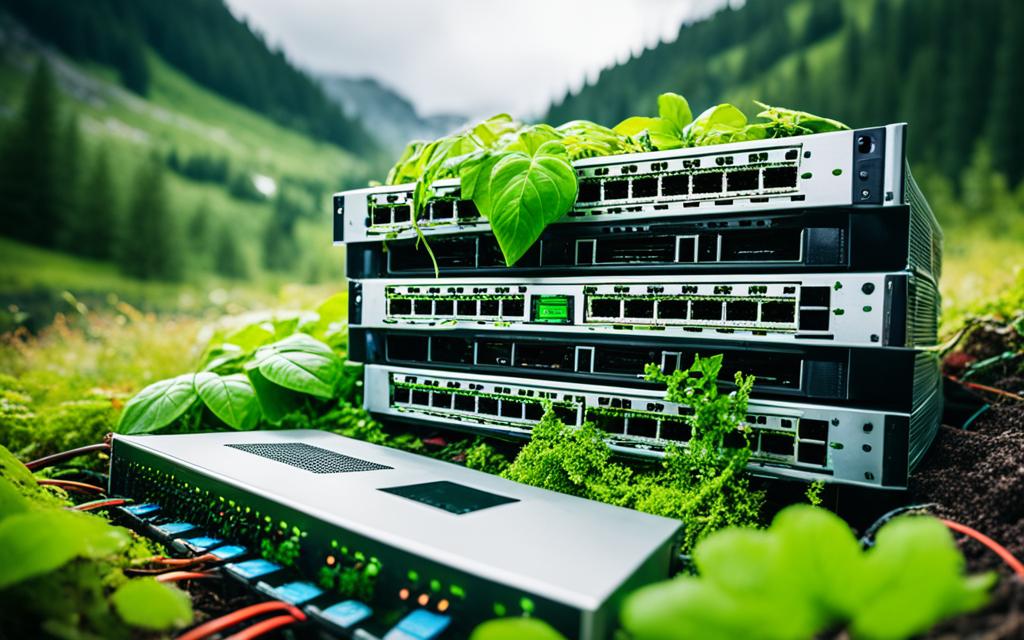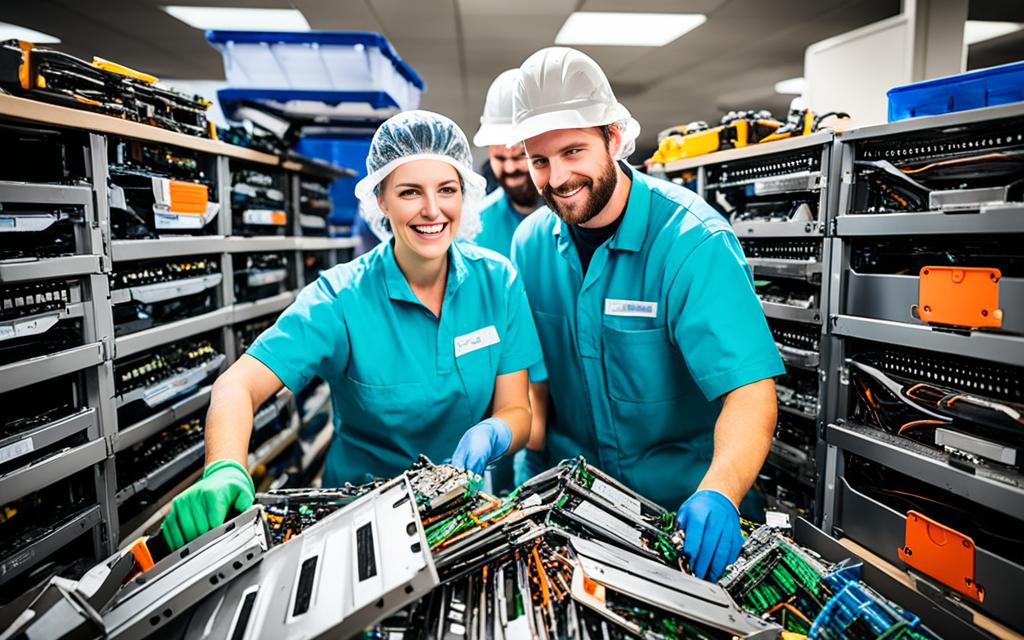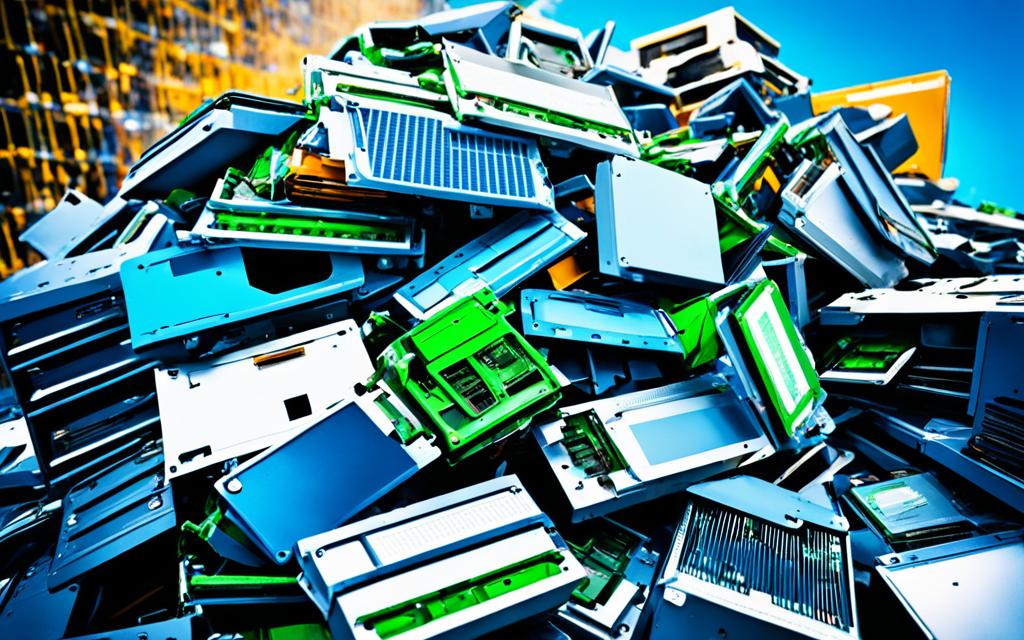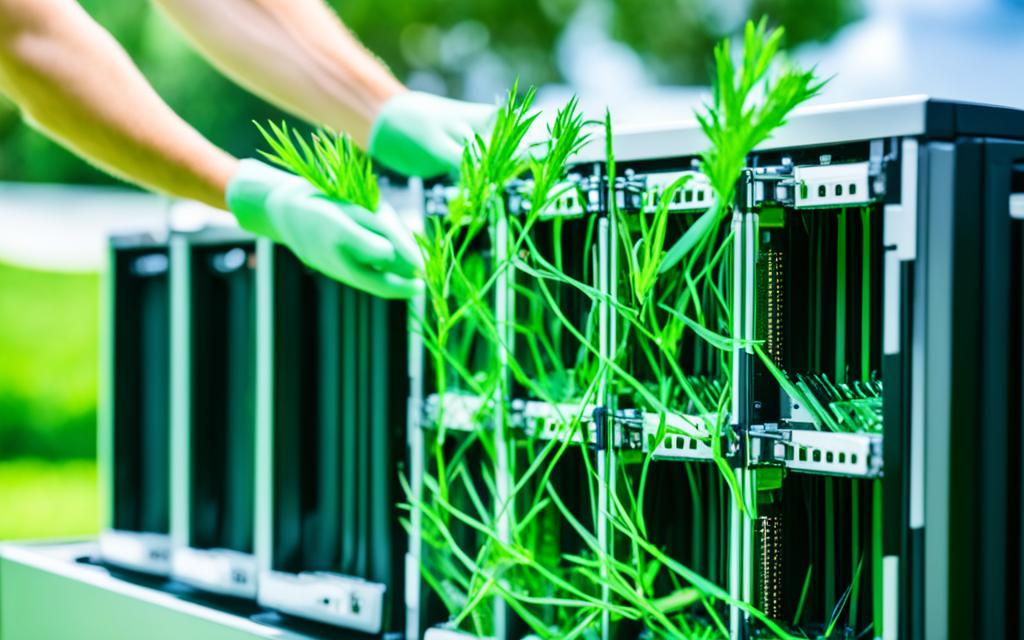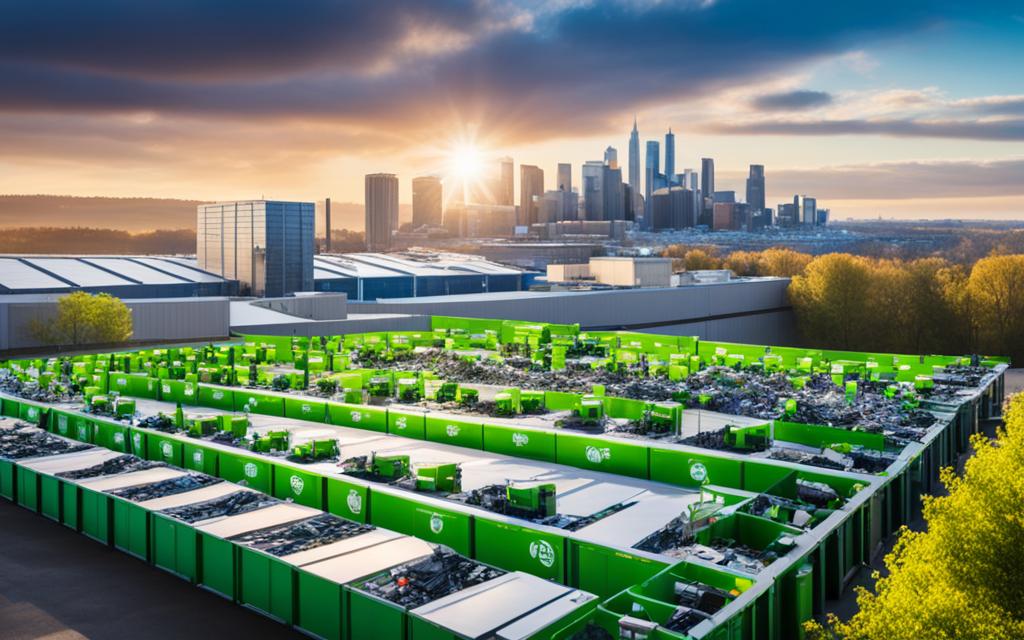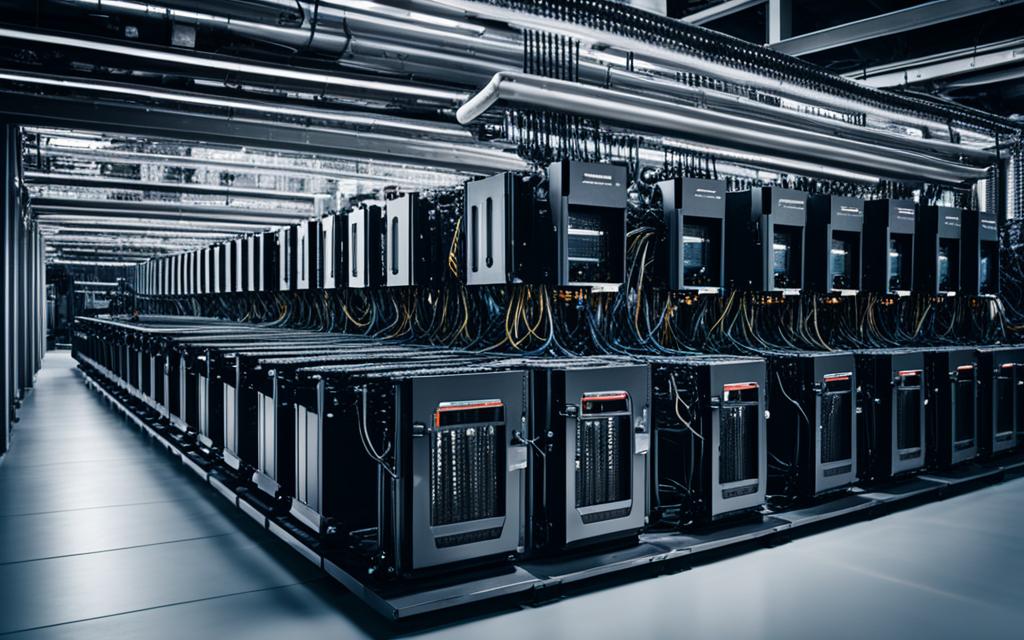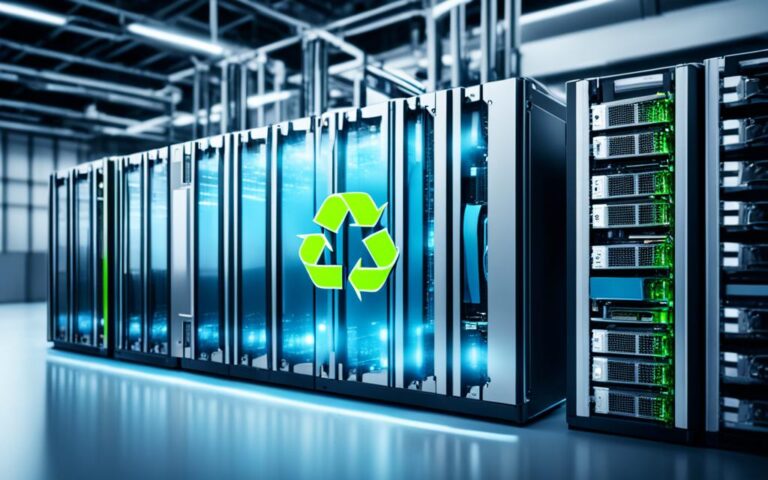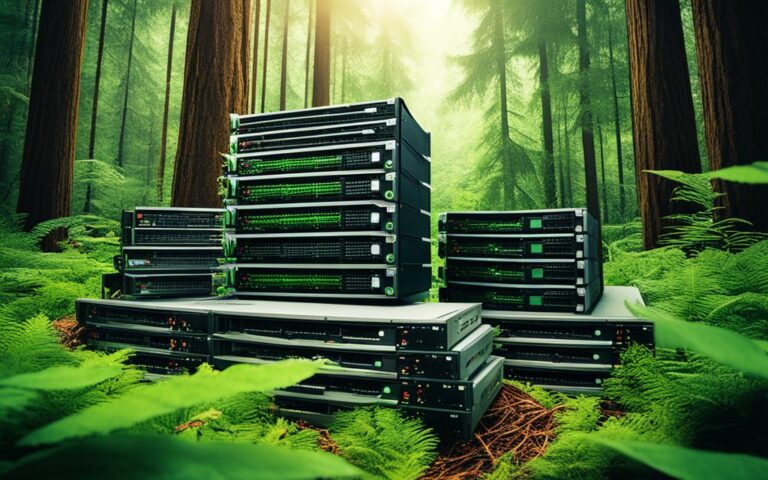Server Recycling: How to Achieve a Sustainable IT Ecosystem
Welcome to a greener future in the tech industry. As businesses strive towards a sustainable IT ecosystem, server recycling emerges as a crucial practice. By embracing responsible server recycling, businesses can effectively reduce their carbon footprint, conserve natural resources, and contribute to a greener future.
The rapid growth of the tech industry has led to a significant increase in electronic waste. Approximately 53.6 million metric tons of electronic waste is discarded globally each year, posing environmental challenges that demand our immediate attention. Sustainable server recycling plays a vital role in preventing environmental pollution and supporting sustainable development goals.
Through proper disposal and recycling of servers, we can eliminate the risk of soil and water contamination caused by hazardous materials. It also helps combat deforestation by reducing the need for raw material extraction. By adopting responsible server recycling practices, businesses can make a positive impact on the environment and contribute to a more sustainable future.
This article will explore the environmental impact of e-waste, the role of IT recycling in sustainable development, the benefits of IT recycling, innovations in sustainable data centre design, corporate responsibility in IT recycling, and provide a comprehensive guide to server recycling. Join us as we dive into the world of server recycling and discover the many benefits it brings to our planet and the tech industry.
The Environmental Impact of E-Waste
Improper disposal of electronic devices can have severe consequences on the environment, leading to soil and water contamination. This contamination occurs due to the presence of hazardous materials such as lead, mercury, and cadmium in e-waste. These substances not only harm ecosystems but also pose significant risks to human health.
Sustainable server recycling plays a crucial role in preventing the release of hazardous materials into the environment. By implementing responsible recycling practices, we can mitigate the negative impact on our surroundings. When electronic devices are disposed of improperly, the hazardous materials they contain can seep into the soil and water, endangering plant and animal life as well as human populations.
“The improper disposal of electronic devices leads to soil and water contamination due to hazardous materials like lead, mercury, and cadmium.”
E-waste is a major concern as it contains toxic substances that can leach into the ground and water sources. This contamination not only disrupts ecosystems but also poses serious health risks to communities. It is essential to address the environmental impact of e-waste and take proactive measures to prevent further damage.
Furthermore, the extraction of raw materials for electronic devices contributes to deforestation and biodiversity loss. Rare earth metals, precious metals, and other valuable resources are extracted from natural habitats, leading to habitat destruction and loss of biodiversity. By embracing sustainable server recycling practices, we can reduce the need for resource extraction, conserve natural habitats, and protect vulnerable ecosystems.
Sustainable server recycling goes beyond just mitigating environmental harm. It presents an opportunity to establish a circular economy where valuable materials from discarded electronic devices are recovered and reintroduced into the production cycle, reducing the demand for new resources. This not only conserves materials but also reduces the overall environmental impact of the tech industry.
The Environmental Impact of E-Waste:
| Environmental Impact | Consequences |
|---|---|
| Soil Contamination | Disruption of ecosystems, loss of soil fertility |
| Water Contamination | Endangerment of aquatic life, risks to human health |
| Hazardous Materials | Exposure to toxic substances, long-term health effects |
| Deforestation | Habitat destruction, loss of biodiversity |
Sustainable server recycling is not only a responsible choice but also an essential step towards building a greener future. By addressing the environmental impact of e-waste, we can preserve our natural resources, protect our ecosystems, and create a more sustainable IT ecosystem.
The Role of IT Recycling in Sustainable Development
IT recycling plays a crucial role in driving sustainable development and fostering a greener future. By aligning with the principles of the circular economy and regenerative design, IT recycling minimizes the environmental impact of e-waste and promotes responsible consumption and production.
One of the key benefits of IT recycling is the extension of the lifespan of IT equipment through refurbishment and recycling. By giving old devices a new lease of life, IT recycling reduces the demand for new devices, leading to resource conservation and a significant reduction in electronic waste.
Furthermore, IT recycling aids in closing the loop of the circular economy by recovering valuable materials from discarded IT equipment and reintroducing them into the production cycle. This process not only reduces the need for the extraction of raw materials but also conserves natural resources.
The integration of IT recycling into sustainable development practices helps create a more sustainable and resilient IT ecosystem. By properly disposing of electronic devices and recycling their components, businesses contribute to the minimization of environmental pollution and the preservation of natural habitats.
“IT recycling is not just about waste management; it is a strategic approach that addresses the urgent need for sustainable solutions in the tech industry. Through responsible IT recycling, we can pave the way for a regenerative future.”
– Emma Green, Sustainability Expert
Overall, IT recycling plays a vital role in achieving sustainable development goals by minimizing the environmental impact of e-waste, conserving natural resources, and promoting a circular economy and regenerative design principles.
The Benefits of IT Recycling in Sustainable Development
IT recycling offers a multitude of benefits for sustainable development and the IT industry as a whole. These benefits include:
- Reducing the environmental impact of e-waste by diverting electronic devices from landfills and preventing hazardous materials from contaminating the environment.
- Creating job opportunities in the recycling industry, contributing to economic growth and social well-being.
- Enhancing brand image and corporate responsibility, attracting environmentally conscious customers and fostering loyalty.
By embracing IT recycling, businesses can contribute to a more sustainable future while reaping numerous benefits for their bottom line and reputation.
The Benefits of IT Recycling in Sustainable Development
IT recycling plays a crucial role in achieving sustainable development goals by addressing the environmental impact of e-waste and creating a positive social and economic impact. Let’s explore the various benefits that IT recycling brings to the table.
1. Reducing Environmental Impact
By diverting electronic devices from landfills, IT recycling significantly reduces the environmental impact of e-waste. Electronic devices contain hazardous materials such as lead, mercury, and cadmium, which can contaminate soil and water if not properly disposed of. Responsible IT recycling ensures these materials are safely extracted and treated, preventing environmental pollution and safeguarding ecosystems.
2. Job Creation
IT recycling creates job opportunities in the recycling industry, contributing to economic growth and social well-being. Recycling facilities require skilled workers to handle the process of dismantling, sorting, and recycling electronic devices. These jobs provide employment and income for individuals, supporting local communities and fostering a sustainable economy.
3. Enhancing Brand Image
“Responsible IT disposal demonstrates corporate responsibility and enhances brand image, attracting environmentally conscious customers and fostering customer loyalty.”
In today’s eco-conscious world, consumers actively seek out brands that prioritize sustainability. By adopting responsible IT recycling practices, companies demonstrate their commitment to environmental responsibility, which enhances their brand image. This attracts environmentally conscious customers who are more likely to support and remain loyal to a brand that aligns with their values.
4. Contributing to a Circular Economy
IT recycling promotes the principles of a circular economy by extending the lifespan of IT equipment. Through refurbishment, repair, and recycling, discarded IT devices can be transformed into valuable resources. This reduces the demand for new devices, conserves natural resources, and minimizes waste generation, contributing to a more sustainable and efficient use of resources.
| Benefits | Description |
|---|---|
| Reduces environmental impact | Prevents e-waste from contaminating the environment |
| Creates job opportunities | Contributes to economic growth and social well-being |
| Enhances brand image | Attracts environmentally conscious customers |
| Contributes to a circular economy | Minimizes waste generation and conserves resources |
IT recycling has a profound impact on sustainable development, addressing the environmental challenges posed by e-waste while creating positive social and economic outcomes. By recognizing the benefits of IT recycling and integrating responsible practices into their operations, businesses can contribute to a greener future and build a sustainable IT ecosystem.
Innovations in Sustainable Data Centre Design
Sustainable data centre design is at the forefront of efforts to reduce the environmental impact of data centres. By implementing innovative solutions, data centres can optimize energy efficiency, reduce operational costs, and contribute to a greener future. This section explores some of the key innovations in sustainable data centre design, including cooling solutions, regenerative design principles, and onsite power generation technologies.
Cooling Solutions
Cooling is a critical aspect of data centre operations as it helps maintain optimal temperature levels for server equipment. Sustainable data centre design focuses on implementing cooling solutions that optimize energy efficiency and reduce dependence on traditional cooling mechanisms. Two innovative cooling solutions gaining traction in the industry are direct-to-chip cooling and immersion cooling.
Direct-to-chip cooling: This solution involves placing cooling mechanisms directly on the processors of the server, allowing for more efficient heat dissipation and reducing the need for large cooling systems. By minimizing energy consumption for cooling purposes, data centres can significantly reduce their carbon footprint and operational costs.
Immersion cooling: In immersion cooling, servers are submerged in a dielectric fluid that efficiently dissipates heat. This method eliminates the need for traditional air-cooling systems, reducing energy consumption and enabling higher density server deployment. Immersion cooling is not only more energy-efficient but also helps address space constraints in data centre facilities.
Regenerative Design Principles
Regenerative design principles aim to create sustainable ecosystems within and around data centres, promoting biodiversity, improving air quality, and reducing environmental impact. By incorporating green infrastructure, data centres can contribute to the restoration and enhancement of local ecosystems while meeting their operational needs.
Green infrastructure: Sustainable data centre design integrates green spaces, such as rooftop gardens, vertical gardens, and green walls, into the design of the facility. These green elements enhance air quality, absorb carbon dioxide, and provide habitat for local flora and fauna. Green infrastructure also helps mitigate the heat island effect and reduces energy consumption for cooling.
Onsite Power Generation
Onsite power generation technologies offer sustainable energy sources for data centres, reducing reliance on grid-based electricity and minimizing environmental impact. One such technology gaining prominence is green hydrogen, which can be produced through renewable energy sources and used as a clean and efficient power source for data centres.
Green hydrogen: Green hydrogen is produced by using renewable energy sources, such as solar or wind power, to power electrolysis, which separates hydrogen from water. The generated green hydrogen can then be used as a clean energy source for data centre operations, reducing carbon emissions and supporting sustainable power generation.
| Innovations | Benefits |
|---|---|
| Direct-to-chip cooling | – Optimal heat dissipation – Reduced energy consumption – Lower operational costs |
| Immersion cooling | – Higher density server deployment – Energy-efficient cooling – Address space constraints |
| Regenerative design principles | – Enhanced biodiversity – Improved air quality – Reduced environmental impact |
| Onsite power generation | – Reduced reliance on grid-based electricity – Lower carbon emissions – Sustainable power sources |
By integrating these innovative solutions into data centre design, organizations can achieve significant advancements in sustainable data centre operations. The combination of energy-efficient cooling, regenerative design principles, and onsite power generation technologies contributes to a more sustainable and eco-friendly digital infrastructure.
Corporate Responsibility in IT Recycling
Corporate responsibility plays a crucial role in driving sustainable practices in IT recycling. Businesses have the power to shape a greener future through their commitment to responsible e-waste management. By adopting efficient IT recycling practices, companies not only reduce waste disposal costs but also contribute to a circular economy by recovering valuable materials for profit.
Emphasizing corporate responsibility in IT recycling goes beyond cost-saving measures. It extends to building a positive brand image and attracting eco-conscious customers. In today’s socially conscious world, consumers actively choose businesses that align with their values of sustainability and environmental conservation. By prioritizing responsible e-waste management, companies can enhance their brand image and foster customer loyalty.
“Sustainable IT recycling is not just about compliance; it’s about being a responsible global citizen and a champion for our planet’s future.” – Mark Smith, CEO of GreenTech Solutions
Adhering to regulations regarding data protection and disposal is another critical aspect of corporate responsibility in IT recycling. Companies must ensure legal compliance to protect sensitive information during the disposal process. By implementing secure data destruction practices, businesses instill trust and confidence in their customers, safeguarding their privacy and reputation.
In conclusion, corporate responsibility in IT recycling encompasses more than just environmental conservation. It encompasses cost-saving measures, brand image enhancement, and legal compliance. By integrating responsible e-waste management practices into business operations, companies can contribute to a sustainable future while reaping the benefits of a positive reputation and customer loyalty.
Key Points:
- Corporate responsibility drives sustainable practices in IT recycling.
- Efficient IT recycling practices reduce waste disposal costs and allow for the recovery of valuable materials.
- Emphasizing responsible e-waste management enhances brand image and attracts eco-conscious customers.
- Adhering to data protection regulations ensures legal compliance and contributes to a positive reputation.
A Comprehensive Guide to Server Recycling
Proper server recycling practices are crucial for preserving data protection, ensuring legal compliance, and minimizing the environmental impact of IT disposal. Servers often store sensitive data, and improper disposal can result in data breaches and reputational harm to businesses. Responsible server recycling guarantees the secure destruction of data, preventing it from falling into the wrong hands and safeguarding the privacy of individuals and organizations alike.
Moreover, server recycling plays a vital role in reducing the negative environmental impact associated with electronic waste. When servers are disposed of improperly, toxic components can find their way into landfills, posing serious threats to ecosystems and human health. By recycling servers through authorized facilities, these toxic materials can be effectively managed and prevented from polluting the environment.
“Proper server recycling practices ensure data protection and prevent toxic components from ending up in landfills.”
Responsible server recycling also contributes to the conservation of valuable resources. Instead of extracting raw materials for manufacturing new servers, recycling allows for the reuse of existing materials, reducing the demand for resource-intensive processes. This conserves materials and energy, resulting in a more sustainable approach to IT infrastructure.
Implementing effective server recycling practices involves a step-by-step approach. This comprehensive guide provides the necessary instructions to ensure secure and environmentally friendly server disposal:
- 1. Evaluate the condition of the server: Before initiating the recycling process, assess whether the server is still functional or can be repurposed internally. If it can still serve a purpose within the organization, consider its potential for redeployment or refurbishment.
- 2. Back up and erase data: Prior to disposing of the server, it is crucial to back up any valuable data and then securely erase all information. Use data wiping software or rely on professional data destruction services to ensure complete data removal.
- 3. Disconnect and uninstall: Disconnect the server from the power supply and carefully uninstall any additional components or cables. Take note of the server’s configuration and any specific requirements for recycling.
- 4. Choose a certified recycling provider: Select a reputable recycling provider that specializes in IT equipment recycling. Ensure they adhere to local regulations and have certifications for responsible e-waste management.
- 5. Arrange safe transportation: Coordinate with the recycling provider to arrange safe transportation of the server to their facility. Take necessary precautions to protect the server during transit.
- 6. Proper recycling and disposal: Entrust the server to the recycling provider, ensuring they follow proper recycling and disposal methods. Certified facilities will dismantle the server, recycle eligible components, and manage hazardous materials in an environmentally responsible manner.
By following these steps, businesses can responsibly recycle their servers, protecting data, complying with regulations, and minimizing their ecological footprint. Responsible server recycling not only ensures a more sustainable IT ecosystem but also demonstrates corporate responsibility and fosters a positive brand image.
Remember: Proper server recycling practices contribute to data protection, legal compliance, and environmental conservation.
The Environmental Impact of Improper Server Recycling
The improper recycling of servers can have severe consequences for the environment. Toxic components, such as heavy metals and hazardous chemicals, can leach into the soil and water, causing pollution and endangering ecosystems. By recycling servers through certified facilities, these harmful materials can be effectively managed and prevented from causing environmental harm.
Additionally, improper disposal contributes to the growing issue of electronic waste, which poses significant challenges globally. Electronic waste, including servers, contains valuable resources that can be recovered through recycling. Failing to recycle these materials perpetuates the demand for resource extraction, leading to further environmental degradation and resource depletion.
| Key Points | Benefits |
|---|---|
| Secure data destruction | Protection against data breaches and reputational damage |
| Prevention of environmental pollution | Reduction in the release of toxic components and prevention of soil and water contamination |
| Resource conservation | Reduction in the demand for raw materials and conservation of valuable resources |
| Brand image and corporate responsibility | Enhancement of brand reputation and attraction of environmentally conscious customers |
Conclusion
Achieving a sustainable IT ecosystem requires businesses to adopt responsible server recycling practices. By minimizing the carbon footprint associated with IT hardware and reducing e-waste, businesses can make a significant contribution to environmental conservation and sustainable development. Not only does server recycling help in reducing the environmental impact of e-waste, but it also plays a crucial role in conserving valuable resources and creating job opportunities. Moreover, it enhances brand image by demonstrating corporate responsibility in the tech industry.
The innovations in sustainable data centre design further bolster the quest for a greener digital future. By implementing energy-efficient cooling solutions, incorporating regenerative design principles, and leveraging onsite power generation technologies, data centres can significantly reduce their environmental impact. These advancements in sustainable data centre design ensure that IT infrastructure is not only efficient but also environmentally conscious.
For businesses looking to make a difference, a comprehensive guide to server recycling is essential. This guide equips organizations with the necessary information to make informed decisions about server disposal. By following proper server recycling practices, businesses can protect data, comply with legal requirements, and minimize the negative environmental effects associated with e-waste. Together, these efforts contribute to building a sustainable IT ecosystem that supports environmental conservation and fosters a greener future for the tech industry.
FAQ
Why is sustainable server recycling important?
Sustainable server recycling is crucial for achieving environmental sustainability in the digital age. It helps minimize the carbon footprint, conserve natural resources, and meet the demand for sustainable technology solutions.
What are the environmental challenges posed by electronic waste?
Improper disposal of electronic devices can lead to soil and water contamination due to hazardous materials like lead, mercury, and cadmium. This contamination harms ecosystems and human health.
How does sustainable server recycling prevent environmental pollution?
Sustainable server recycling prevents the release of hazardous materials into the environment, reducing the risk of soil and water contamination. It also contributes to the conservation of natural resources.
How does IT recycling contribute to sustainable development?
IT recycling aligns with the circular economy and regenerative design principles by minimizing the environmental impact of e-waste and promoting responsible consumption and production. It extends the lifespan of IT equipment, reduces the demand for new devices, and conserves natural resources.
What are the benefits of IT recycling in sustainable development?
IT recycling reduces the environmental impact of e-waste by diverting electronic devices from landfills and preventing hazardous materials from contaminating the environment. It also creates job opportunities in the recycling industry and enhances brand image, attracting environmentally conscious customers.
How do innovations in sustainable data centre design enhance sustainability?
Innovations such as direct-to-chip and immersion cooling optimize energy efficiency and reduce operational costs in data centres. Regenerative design principles incorporate green infrastructure, promoting biodiversity and improving air quality. Onsite power generation technologies like green hydrogen offer sustainable energy sources for data centres.
Why is corporate responsibility important in IT recycling?
Corporate responsibility in IT recycling reduces waste disposal costs, allows for the recovery of valuable materials, and enhances brand image. It also ensures legal compliance in data protection and disposal, contributing to a positive reputation.
How does proper server recycling contribute to data protection and legal compliance?
Proper server recycling ensures the secure destruction of data and prevents toxic components from ending up in landfills. It also reduces the demand for raw resources, conserves materials, and minimizes the negative environmental impact.
How can businesses achieve a sustainable IT ecosystem through server recycling?
By adopting responsible server recycling practices, businesses can minimize the carbon footprint of IT hardware, reduce e-waste, and contribute to environmental conservation and sustainable development. Server recycling benefits include reducing the environmental impact, conserving resources, creating job opportunities, and enhancing brand image.
Where can I find more information on server recycling and disposal?
This comprehensive guide provides step-by-step instructions for effective server disposal, including information on data protection, legal compliance, and minimizing environmental impact.

